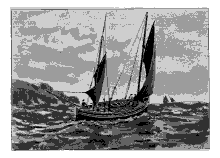The Coble
The glory of the coble Yorkshire
shares with Durham and Northumberland. The coble is one
of the most distinctive types of craft to be found
perhaps in Europe or Asia. She was primarily designed for
launching off beaches against heavy seas, and admirably
she has met this principal requirement. With a
high-shouldered bow, with deep grip, she carries a flat
floor aft to her low stern, beneath which two skorvels,
or shallow bilge keels, help to keep her upright and to
launch her down the beach. A long, deep, dagger-like
rudder, drawing three feet or more, is shipped as soon as
the boat is in deep water. The deep forefoot is useful in
coming head-first off the shore into a breaking sea,
being a help in keeping the head of the boat up to
windward if the wind is on one bow; and in beating to
windward, drawing as it does from two to three feet, it
gives her a powerful grip which, added to the hold given
by the deep rudder, enables a coble to be a very fine
performer on a wind, especially in a sea-way. The
square-sterned boats are the best performers on this
point of sailing, but round sterns are coming into vogue
on account of their superior running power, the
square-sterned boats being very difficult to handle
running before a heavy sea.
MULE
As cobles also generally pull and tow
best stern first, the round stern has obvious advantages
for the fishermen and the pilot. The southern boats have
most of them been built in this manner, and with the
hollow bow at the waterline. The lean, flat stern is in
strong contrast to the powerful appearance of the rest of
the hull, and on the whole, therefore, the increasing
fashion for round sterns is perhaps a gain from the
artistic point of view, for it certainly makes a less
insignificant finish to the boat. They are clinker-built,
with broad sawn timbers of oak or larch, which give them
a curious angular section; there is a pronounced
tumble-home of the topsides, and the planking is finished
flush with the stern.
COBLE-REEFED
The gunwale is worked outside instead
of inside the top strake, and the thowl-pins and pins for
belaying halyards, etc., project on the under side. With
these characteristics, and the broad bands of light
colours with which they are daringly painted showing up
their bold outlines, these boats are beautiful creatures
to meet at sea alive with wind and motion. Their rig is
the simple old brown-tanned dipping lugsail, set on a
raking mast. A small jib is often used in fair weather,
and the racing cobles at Whitburn go in for a mizen also.
But this sail is of little use upon a wind, except to
balance an extra large jib, and is therefore not in
general use. The mast is given greater rake for every
reef taken in the mainsail; and with a reef breeze, and
her mast raked from 8 to 10 feet, the coble will lift
over anything in the shape of a head-sea, and stand
almost any weather if kept by the wind.
A HERRING MULE
At such times the short mast is set,
and the coble is seen to her best advantage; she is
sailed by the sheet, and never luffs to the stiffest
puffs. The coble seems to have followed the fate of
nearly all the most distinctive types of boats in its
increase of size. The Sailor's Word-Book (by
Admiral W. H. Smyth, published 1867) gives the general
size of the coble as 20 feet long by 5 feet beam, and
other old writers speak of it as a 'small boat.' Yet the
coble of today is usually ten to a dozen feet longer than
this, and from 7 to 10 feet beam -- a size not exceeded
by many seagoing open boats. *1*
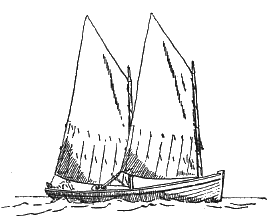 HUMBER
GOLD-DUSTER
HUMBER
GOLD-DUSTER
While the bilge keels and tumble-home
of the top strake of the coble are very suggestive of
Dutch origin, there are certain points in which this boat
seems to retain some relics of distinctly Norse
influence. The simple form of the pins set under the
gunwale for belaying halyards to, the flat shape of the
loom of the oar and its method of shipping with an iron
ring set over a single thowl, as well as the flat head
and low peak of the sail, and the light shades of green
and blue used in painting the hulls, all flavour of what
one meets to-day on the Scandinavian seaboard.
*1* Dimensions of Cobles :
|
COD, LING, AND HADDOCK FISHERY.
|
HERRING FISHERY.
|
WHITBURN COBLE.
|
|
Six lines, 2 miles in length.
|
Carrying 30 Nets, 180 ft. by 3 ft.
|
|
|
3 tons Capacity.
|
9 tons Capacity.
|
|
|
Length 28 ft.
|
33.75 ft.
|
31 ft.
|
|
Beam 5.5 ft.
|
10 ft.
|
7 ft.
|
|
Depth 2.3 ft.
|
4.75 ft.
|
2.5 ft.
|
|
Crew: 3 or 4 men. The length of mainmast is
generally about a foot shorter than the over-all
length, and that of the mainyard roughly half
that of the mast.
|
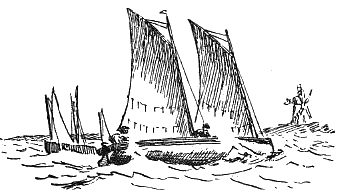
OLD TRENT AND HUMBER BOATS, 1835
The Keel
*1*
This name is now applied in Durham and
Yorkshire to a class of flat-bottomed barge navigating
our north-eastern rivers. The Norse origin of the simple
in vogue is obvious to all who have seen the
old-fashioned Norwegian coaster or the Nordland boat,
running or beating among the northern islands. The tall
light mast carries a simple squaresail. The main halyards
tie is of chain, and leads through a sheave below the
main rigging, and aft to a purchase worked by a small
hand-winch in front of the helmsman. In fine weather a
small square topsail is carried, hoisting to a sheave in
the masthead. A pair of shrouds on each side, and a
strong forestay, form the only rigging; by means of the
latter and the windlass the mast can be quickly lowered
and raised again, all standing in shooting
bridges.
*1* An old British name for long vessels, formerly
written ceol and cynlis. Verstegan informs
us that 'the Saxons came over in three large ships, by
themselves Keeles.' -Admiral W. H. Smyth.
Swiz. Ceol =barge or small vessel.
Iceld. kjoll =barge or ship.
Dan. kiel =vessel.
The term is known for the square-rigged barge from
Norfolk to the Tyne.
The keelmen agree that the square rig
is the simplest and handiest for its purpose, and is
preferable to a fore-and-aft rig for inland navigation.
Its main disadvantages are felt when tacking. For this
the two hands forming the crew must be on
deck.
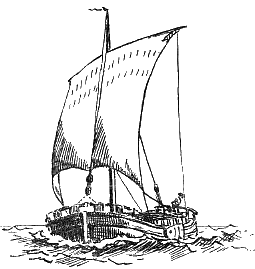 HUMBER
KEEL
HUMBER
KEEL
As soon as the ship is round, and the
sail well aback to pay her off, the sheet and tack are
let fly, the lee sheet and weather tack rope are quickly
hauled in, as the sail swings, through nocks on the
gunwale which lead to small hand-winches stepped for the
purpose on each side of the long main hatchway at the
fore and aft ends of the vessel. The tack is hauled down
taut, while the sheet is trimmed to the wind; this often
cants the yard until it looks like a square-headed
lugsail. The lee and weather braces are in one piece, the
bight being overhauled by the helmsman to brace round the
lee yardarm. In going to windward the weather leech is
often tautened by a bowline leading forward, and the
keelmen claim that when on a wind they can look a point
closer than any fore-and-aft rigged vessel; and any one
who has seen them beating down the Humber in a strong
easterly wind, will agree that on the whole they have
good reason to be proud of the set of their
sails.
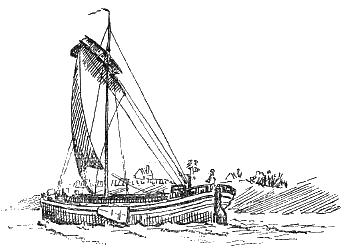 KEEL
KEEL
In a strong wind, however, staying
these boats is no child's-play, as the powerful sail is
all adrift when being swung and takes charge freely,
while before the sail is reset and trimmed the boat has
often made three lengths of sternway. The bow and quarter
rails are very reminiscent of Dutch scenery, though an
inartistic blue seems to be coming into favour in
preference to the older and prettier bright green with
red and gold touches here and there. For inland
navigation the leeboards, anchors, and dinghy are left
behind, and ultimately the mast; yards are stowed on
deck, sails below, and the very winches unshipped to
enable them to pass beneath the low inland bridges; and
thus denuded these boats may be met with at Leeds or
Liverpool, or in the heart of Lincolnshire. They look big
and safe enough in these quiet inland waters, but seen
off Grimsby from the bridge of a steamer in a big
north-easterly swell and a strong breeze, their freeboard
seems none too much. *1*
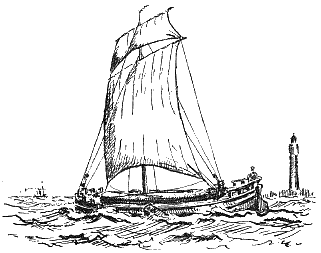
KEEL
The keel is undoubtedly the finest
inland navigation boat we have in this country. Inland
navigation, except in the Fen counties, is not nearly so
developed in England as it is on the great inland
waterways of the Continent, and naturally so. But while
making due allowance for the smaller size of our rivers
and canals, the ordinary canal-boat is a sorry piece of
naval architecture at the best, and the keel is a
refreshing change.
*1* The usual dimensions are about 58 ft. by 14 ft. 6
inches by 5 to 6 ft. draught when loaded, and they carry
from 70 to 80 tons of cargo.
The barges used in the Mersey are, it may be noted,
practically keels in all but their fore-and-aft rig, and
their more grimy appearance.
|
Humber Keel Sail
Dimensions
|
|
|
MAINSAIL
|
TOPSAIL
|
|
HEAD
|
22'9
|
22'9
|
|
FOOT
|
34'0
|
26'3
|
|
LEECHES
|
31'6
|
11'6
|
|
DEPTH IN
CENTRE
|
25'6
|
11'0
|
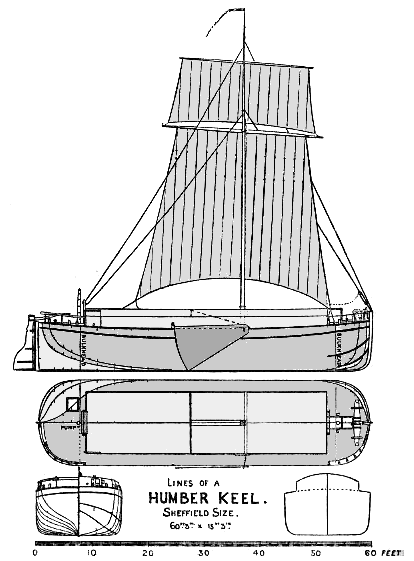
KEEL
(BY KIND PERMISSION OF THE HUMBER YAWL
CLUB)
The coal-carrying keel on the Tyne, of
which comparatively few survive, has quite forsaken its
old square rig in favour of the fore-and-aft sprit main
and staysails. In fact, the Tyne keel of the present day
is much more like the Mersey barge both in appearance and
rig than its sister of the Humber. It is interesting,
historically, that at the beginning of the last century
it was among the Teignmouth keels that centre-boards were
first given a trial, about the time that the Admiralty
were making experiments with the Lady Nelson sixty ton
brig; but the centreboard does not appear to have taken
on.
MERSEY LIGHTER
Owing to the narrower waters they
navigate, these boats were always a much smaller class of
vessel than the Humber keel now is. Their dimensions were
about: length, 42 feet; beam, 19 feet; draught, 4 feet 6
inches; capacity, 21 tons. *1* It is said that about the
forties in the last century, carvel build gave way to
clinker building, whence the smaller Tyne wherry. As a
rule, development is in the reverse direction, and
classes of boats in these isles increasing in size, are
apt to leave the clinker for the carvel style of
build.
*1* The dimensions are from Notes and Queries for
Jan. 26, 1901, which gives other interesting
particulars.
First-cousin to the keel of the
north-east coast is the ordinary humble lighter, barge,
or flat, variously called, more variously rigged, but
invariably grimy, hard- working, and of little repute.
Yet despise it not, for in that low freeboard,
square-ended little craft, life, real life is to be met
with.
THE HUMBLE LIGHTER
Navigating over wide, stormy
estuaries, east, west, and north, in dripping fog-bank
and howling gale, in glaring sun and black night, without
shelter or help, and but a little simple rope and canvas,
two men, or a man and boy, carry thousands of tons of
this country's merchandise, year in, year out, with
unfailing regularity and certainty. In simplicity and
efficiency they are not excelled.
The Norfolk Coast
Coming southward along the east coast
we may pass by the Humber, with Hull and Grimsby, the
great northern trawling ports, in these days full of iron
steam-trawlers, across the entrance to the intricate
channels of the Wash, to the twin ports of Lowestoft and
Yarmouth. With the decay of Harwich as a fishing-station
during the last century, these two ports, favoured by
their situation well out in the North Sea and near to the
trawling-grounds then beginning to be systematically
worked, have become the home of the largest sailing-fleet
of trawlers and drift-net boats in our
islands.
OLD CUTTER, 1818
(AFTER W. DANIELL)
At the beginning of the century
deep-sea trawling was in its infancy, and before the
advent of railways no fisherman went farther from his
market than he could avoid. Simultaneously with the
increased sea traffic in our estuaries steam came in, and
while it helped to scare the fish out from many portions
of the shoreline, it enabled the fisherman to go farther
afield and to use the port nearest to his fishing-ground
rather than that nearest to his market. Although
Lowestoft and Yarmouth, therefore, are ancient ports,
their importance as fishing-stations is of recent origin.
Brought up among the drift-net fishermen of the west
country, one was educated to look upon 'east countrymen,'
as the Lowestoft and Yarmouth boats were known, as
sacrilegious Sunday-breakers and outer barbarians
generally, and we used to criticise them from our small
boat much as the small-line man does the trawler, the
pedestrian the cyclist, or the teamster the scorching
motor.
OLD YARMOUTH YAWL
Consequently, when one first moored up
alongside their long wharves, it was with some surprise
one began to find the Lowestofters much as other sailor
men, and East Anglia not only a delightful country, but
one from which several remarkable types of naval
architecture have emanated -- a fact which argued even to
our prejudiced west country mind a high state of
civilisation. In fact, to give the Norfolk coast its due,
there are few coastlines of equal length which have done
more in this direction.
The far-famed old Yarmouth yawls are
unique, and with the exception of some tropical-built
canoes, are probably the largest open boats in the world.
They are long, narrow, clinker-built boats, stem and
stern alike, with very fine entrance and clean run, and
are often 50 feet in length with 10 to 11 feet beam. The
older boats often exceeded 50 feet in length, the
Reindeer, which challenged the America, being stated to
have been 69 feet and to have sailed sixteen knots on a
reach.
ARMED LUGGER, 1825
These boats were rigged with three
lugsails and jib. This three-masted lugsail was a very
favourite one at the beginning of the nineteenth century
among sailors on both sides of the Channel. It appears to
have emanated from the Breton coast, and at a time when
the French fleets were beaten off the seas by the
British, these gallant sailors were able to carry on very
harassing warfare with their three-masted armed luggers.
The old bluff-bowed king's cutter on this side of the
Channel was no match in speed for these easy-lined French
luggers, as the flourishing smuggling trade abundantly
proved at an even much later date, and the bellying cut
of the fore-and-aft sail of that day made it impossible
for our armed cutters to compete with the lug-rigged
vessels from across the Channel in weatherly
work.
KING'S CUTTER, 1825
(FROM A SKETCH
BY SIR W. WARINGTON SMYTH)
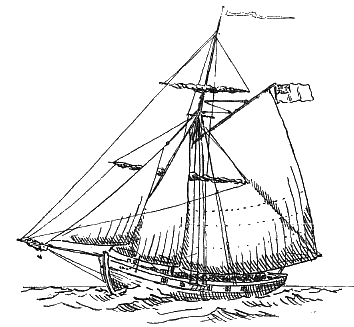 Hence
it came about that our own navy adopted the rig for
certain classes of small craft, and it was also used in
vessels of from 50 to 60 tons both at Whitby and
Yarmouth. It was so sufficiently a national rig in the
middle of the century that, in Folkhard's first edition
of The Sailing-Boat, this rig was given as being
characteristic not only of the Yarmouth beach yawl, but
also of the Hastings boats. It is interesting, therefore,
to note that in both cases the three-masted lug rig very
soon gave way to the present form of main (dipping) lug
and mizen (standing) lug, which (with the addition often
of a running bowsprit and small jib) may be regarded as
the most typical rig of the British fisherman.
Hence
it came about that our own navy adopted the rig for
certain classes of small craft, and it was also used in
vessels of from 50 to 60 tons both at Whitby and
Yarmouth. It was so sufficiently a national rig in the
middle of the century that, in Folkhard's first edition
of The Sailing-Boat, this rig was given as being
characteristic not only of the Yarmouth beach yawl, but
also of the Hastings boats. It is interesting, therefore,
to note that in both cases the three-masted lug rig very
soon gave way to the present form of main (dipping) lug
and mizen (standing) lug, which (with the addition often
of a running bowsprit and small jib) may be regarded as
the most typical rig of the British fisherman.
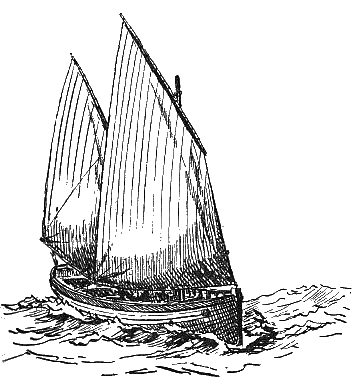 Even
the long, sharp-lined beach-yawl has discarded the old
mainmast, enlarged the dipping-lug foresail, and brought
the mizen well inboard, increasing its area to about
two-thirds that of the foresail.
Even
the long, sharp-lined beach-yawl has discarded the old
mainmast, enlarged the dipping-lug foresail, and brought
the mizen well inboard, increasing its area to about
two-thirds that of the foresail.
SERVICE 23-FEET CUTTER
The existing rig today, therefore, is,
notwithstanding the far greater length of the beach yawl,
identical with that used for the service cutters in the
navy, a fact which goes far to prove the contention of
some of my naval friends that this rig is the handiest
and most powerful which can be put into an open boat with
a strong crew on board, the latter being a very essential
condition to its success. In the meantime, on the south
side of the Channel, the French have loyally adhered to
what may be regarded as the national small-boat rig, and
the three masts with bowsprit and maintopsail may be very
generally seen to this day anywhere west of Nieuport and
Blankenburg, alike in trawlers, traders, and men-of-war
service-boats.
LOWESTOFT BEACH-YAWL
The great length, fine lines, and
shallow draught of the Norfolk beach yawl would seem to
indicate a very fast and capable smooth-water vessel, and
it is nothing less than marvellous that these boats
should be such magnificent vessels in the very heavy
weather which is the rule when their crews put to sea.
Yet they are in reality designed and used almost entirely
for bad weather, their business in life being the
succouring of men and ships when no other craft but the
splendid sailing lifeboats of the National Lifeboat
Institution can put to sea. Such work in the largest and
most powerful of the Institution's modern lifeboats is
dangerous enough, but in a big open boat such as the
beach yawl, in the confused and dangerous sea which runs
in heavy weather along the banks off the Norfolk coast,
it calls for greater nerve and smarter handling than any
salt-water job known to seamen. Before the days of the
National Lifeboat Institution, the whole of the life and
property-saving work on the coast was carried on by the
beachmen's companies either in the big sailing yawls or
in the smaller gigs.
OLD SMACK 1820
(AFTER W. DANIELL)
There are now only some half-dozen of
these companies left along the Norfolk coast, but they
still do their fair share of salving notwithstanding the
rivalry of the Institution's fine sailing lifeboats and
of the powerful modern steam-tugs, which also show no
reluctance to venture in among the banks if a ship is in
distress and there is enough water for them. While the
gigs belonging to the companies pull from eight to ten
oars, the yawls carry crews of between twelve and twenty
men, a big crew being necessary both in launching these
big boats through the heavy surf, and in handling sail,
bailing, and bearing assistance on board distressed
vessels.
EAST COAST DEEP-SEA TRAWLER
Nothing is more common than for small
coasting-schooners, ketches and the like, to get into
trouble for sheer want of hands and weight of bone
sufficient to cope with emergencies in a hard wind, and a
few strong Norfolk hands out of a plunging beach yawl
have time and again saved crew, ship, and
cargo.
Of the fishing-fleets sailing out of
Yarmouth and Lowestoft, the drift-net boats are probably
the more interesting from the present point of view.
While the trawlers, fine, powerful, sea-keeping craft, of
from 60 to 90 tons, have developed out of the category of
boats and have all adopted, with wonderful unanimity, the
handy North Sea ketch rig in common with their sisters
from Grimsby and Ramsgate, the smaller 'driving' boats
have had a history and have evolved a rig quite their
own. The deep-sea trawlers from these ports are among the
finest productions of any fishing industry in the world,
but are beginning to give way to the steel steam trawler
which was the production of the last sixteen years of the
last century.
OLD YARMOUTH LUGGER, 1874
But the old sailing smacksmen of the
North Sea will not be forgotten, even when everything
carrying a trawl is under steam, by any one who has seen
their fleets and sailed with them. They have set fashions
even in the yachting world: the ketch rig is common among
yachtsmen now, and even the old habit of carrying a
jib-headed topsail over a reefed mainsail, which I can
remember hearing stigmatised as 'only a smacksman's
dodge,' is now perpetuated with regularity in the
smartest of the Y.R.A. classes in a blow. Although a few
steam-drifters are now coming in, sails will probably
long continue to hold their own in this fishery.
Houldsworth, in his Deep-Sea Fishing, 1874, gives several
cuts showing the Yarmouth drift-net boat of that day,
from which it is evident that, with a few slight
differences, these boats were practically identical in
rig with the present Brighton and Hastings
luggers.
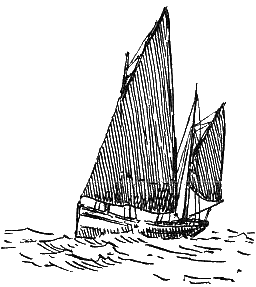 SPLIT
LUG
SPLIT
LUG
The Norfolk boats, however, have had
the advantage of deep-water havens, and have therefore
steadily increased in size, while the southern boats are
handicapped by the necessity of beaching in the absence
of anything in the way of a protected harbour, and have
consequently had to be kept down in size. There is no
doubt that one of the contributory causes to the
alteration in rig which has taken place in the Norfolk
drift-boats since the seventies, is the Norfolk practice
of taking to sea for the season a number of unskilled
hands from the shore. These men
form the majority of each crew, and are taken mainly for
the purpose of handling the nets. The other principal
cause has been the increase in the size of the boats
themselves. The disadvantages of the big dipping lugsail
become more and more apparent as the size increases, and
the danger attending the handling of this sail in strong
winds and high seas becomes infinitely increased when it
has to be done by an inexperienced crew, or by a
short-handed one.
LOWESTOFT DRIFT-NET BOAT
The configuration of the banks off the
Norfolk coast also makes a long series of short tacks
often necessary, and the fore-and-aft rig, with its
quickness and handiness in going about, has advantages on
such a coast not to be disregarded. The result has been
that the Norfolk men have practically gone in for the
split lugsail. The luff of the old dipping lugsail before
the mast has become a small staysail of almost identical
proportions.
LOWESTOFT DRIVER-ALL SAIL
The fore-and-aft mainsail retains
roughly the size and shape of the former lugsail as it
stood abaft the mast. The foot is cut so that the sail
sheets to an iron horse just before the mizen-mast, and
no main boom is used. Practically no alteration has been
made in the placing of the masts, and consequently the
long space between them available for handling fish and
nets, which is one of the principal advantages of the lug
rig, is retained. The forward rake of the mizen, which
has been adopted in the majority of large mizen-carrying
fishing-craft at the present day, has been exaggerated in
a remarkable degree in these boats. In place of the old
standing lug-mizen this has also been made a fore-and-aft
sail, fitted with a boom along its foot, sheeted to the
end of the round counter. The convenience about this sail
is that, when lowered, it is gathered up by its lacing or
mast rings on the mast, out of the way of the crew, the
bunt of the sail being easily made up on the gaff, and
the boom topped up. Everything is thus stowed out of the
way, and the long mizen jigger is got rid of.
LOWESTOFT DRIVER BAD-WEATHER RIG
There is a little more gear aloft in
this than in the usual lug rig, for the pole-mast is
adhered to, and when lying to nets the fore-mast is
lowered aft by means of the forestay and a tackle and
winch, just as in the case of the lug. There is the
additional advantage that the small staysail may be
replaced by a balloon staysail, the most powerful of
fine-weather sails in light winds, and yard topsails can
be easily set on both masts. Both main and mizen sails
are fitted with bonnets by which the weight and size of
the sails are easily reducible in hard weather. The build
of the boats themselves has improved remarkably of late
years. The newer boats are large carvel-built vessels of
remarkably sweet lines. A handsome round counter is the
rule, in place of the old counter overhanging the
transom-stern below.
GORLESTON CRABBER
The bow is clean, but full enough to
give lifting power in a seaway. A considerable number of
these boats have been built in Cornwall of recent years.
The small local open and half-decked boats employed in
shrimping and long-lining are rigged in the regular
Norfolk fashion well known on the Broads, namely gaff and
boom mainsail, and one large jib set on a longish
bowsprit. An enormous gaff topsail completes the outfit.
They are beamy boats, with a broad transom-stern and
centre-board, and carry their pile of brown canvas well,
and in short are a very handy type of craft.
The Wherry
The boat par excellence of Norfolk is,
however, the wherry, employed upon the inland navigation
of the Broad district.
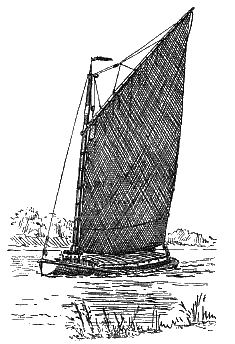 WHERRY-WHOLE
WITH BONNET
WHERRY-WHOLE
WITH BONNET
She is, perhaps, the best known of our
distinctive types of sailing-craft by reason of the
accessibility of the Broads to large numbers of our
fellow-countrymen who prefer sailing close to a bank by
day, and tying up to a bush in safety by night, to
practising the art of seamanship among the uncertainties
and excitements of tidal waters. The form of the black,
high-peaked sail brings back to many recollections of
healthy days among quiet scenes, first impressions of the
unreasoning strength of the self-willed jib-sheet, of the
obstinacy of the reluctant quant, of the tenacity of
certain kinds of mud, or lessons in hard facts about
blocks and ropes and saucepans, which are well for any
man to have, and are nowhere better got than in the
Broads at Easter, or in a wet summer.
It is in autumn, winter, or early
spring that the deep-water boat-sailor will most
appreciate the qualities of the Norfolk wherry, and the
admirable handling to which she is subjected by her crew.
When the bonnet is off the mainsail, and a cold wind
howls through the big forestay, the wherry is at her
best. For there is skill and nerve required to take
thirty tons of cargo and fifty feet overall length
through the narrow rivers of the Bure or Ant in half a
gale of wind; yet the wherry's skipper, with the possible
assistance of his wife or son, thinks nothing of it, and
would feel far less sure of himself if he had thirty
miles of comfortable sea-room on every side of
him.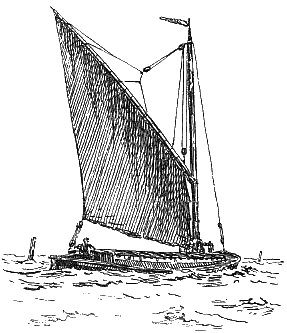
WHERRY-REEFED
The wherry is a light-displacement
boat, the first necessary qualification for shallow-water
navigation. The draught unloaded is under 2 feet 6
inches, with a beam of 13 feet, and length of about 52
feet. The bow is short and hollow, and the greatest beam
is well forward, partly no doubt to carry the big mast,
which is placed under a quarter of the length from the
stem. The stern is sharp, wherry-fashion, and the run aft
is fine.
The mast, a fine stout spar about 40
feet to the hounds, has but a single forestay, by which
it is lowered and hoisted in its tabernacle, 30 cwt. of
lead bolted to its foot making this manoeuvre the
simplest of matters. Simplicity is the keynote of the
wherry's rig, and a single halyard hoists the long
30-foot gaff. The halyard, by an arrangement seldom seen
elsewhere, runs through the large double block at the
masthead to a single block at the throat, back to the
second sheave of the masthead block, and so to the peak,
where a bridle distributes the strain. The arrangement is
so simple and efficient that I often wonder it is not
more extensively used in small craft carrying
fore-and-aft sails. The wherry's sail has no boom, and
the sheet travels on a horse on the after end of the
cabin-top, in front of the helmsman. It is a lesson in
light-displacement sailing to see the wherryman leaning
with his hands in his pockets against his tiller, dodging
along the leeward shore, now and then luffing off a
little, but mostly depending on the pressure of the water
between the mud to leeward and the sharp bow to shoulder
his ship off to windward. In this way, with hardly any
diminution of speed, the wherry will work along a reach
close-hauled, with the wind so far ahead that she can
hardly lay it, while a heavy-displacement boat has to
tack many times to keep off in deep water, and if she
does not completely avoid the neighbourhood of the mud, a
big wave drags up astern, emptying and filling the dykes,
and deadening her way until she seems almost to be
aground. The other most striking manoeuvre of the wherry
man is that of shooting a bridge, when he douses sail,
lowers the mast, hoists all up, and is under way again in
about a minute and a half. A considerable number of these
boats are now built and fitted as pleasure-boats, the
long hold and raised hatches making absolutely perfect
accommodation. For cruising in sheltered waters it is
safe to say that no boat can equal the wherry, but don't
ever be beguiled to sea in one. In the smallest wind and
sea the wherry loses her head entirely, and develops a
suicidal tendency to bury herself and crew.
The Thames Estuary
When Edward the Confessor builded his
great church to the glory of God and the honour of the
blessed Saint Peter, where Henry's proud Abbey of
Westminster now stands, it is recounted that upon the eve
of the consecration, a solitary fisherman was hauling his
nets from his boat upon the shallows of the wide river. A
venerable-looking traveller hailed him from the shore and
asked that he might be ferried across to the new Abbey
Church upon the Isle of Thorney, and forthwith as the
stranger landed the great windows of the church were
filled with light, and the lofty stone vaulting with the
glorious music of the Hosts of Heaven. And thus was the
church that night consecrated by the heavenly choirs and
by the holy Saint Peter himself.
PETER BOAT
No coin did the saint leave on the
after thwart of the poor fisherman's little boat, but a
blessing to all good Thames fishermen, which has lasted
down to our own times -- until the days when Satan, as
some do aver, placed steamboats to ply upon the river,
and stone embankments along its shallows, and turned it
into little better than a tidal mill-sluice.
Such is the first authentic record
which we have of the little 'Peter' boat, which has been
a characteristic Thames type longer than the present
Abbey walls have stood. The grateful fisherman after that
long-remembered night evidently took the liberty of
calling his boat after the fisherman's saint who had so
honoured his humble craft, and so the name was handed
down, and the simple build of the old Thames fisherman
remained characteristic of the river, so that even as
late as 1901, when the writer was last at Putney, two
weather-worn little Peter boats lay there as it had been
eight centuries ago. In E. W. Cooke's time these little
boats were still fairly common above and below Bridge,
and he depicted them frequently. They were shorter than
the old Thames wherry, more beamy, and higher in the
side. They were stem and stern alike, and had no gunwale
(wherry fashion), and being sturdy in build could carry
sail and stand rough water when required. They had a
fish-well nearly amidship, and were probably the first
form of well-boat built for fishing purposes among
Western nations.
The Hatch-boat
The Thames Hatch-boat, the glory of
the Thames before steam days, was an offspring of the
humble Peter boat; it had its origin in the need of the
fisherman for larger boats in the rough tidal waters of
the lower Thames and a large class of wherry-built
sailing-boat with a half-deck and cabin shelter came into
use both for fishing and for general waterman's work
among the shipping. The late Mr. Cooke seems to have
taken a real pleasure in delineating these boats, and
there is no doubt that they were among the smartest of
the smaller sailing-craft of their day. Rigged at first
with the simple old spritsail and foresail, than which
there is still no better setting, handier rig for a small
open boat, they soon had added a topmast to enable them
to catch the light airs floating above the river banks in
fine weather. The sheets ran upon a horse, and the
mainsail was quickly and easily brailed into the mast. In
the larger boats a regular gaff mainsail was eventually
adopted, without a boom, and fitted with brails as in the
older spritsail, and vangs controlled the
gaff.
OLD THAMES HATCH-BOAT
(AFTER E. W. COOKE, R.A.)
A small mizen was often added, and
running bowsprit, and the boats reached eight and ten
tons burden, with roomy cabin and well-space. But to the
last even the largest of the hatch-boats retained the
beautiful wherry model, the sharp stern, and the yoke
steering gear common to the tribe. And what beautiful
cruising boats they would have made to the modern
Corinthian yachtsman!
OLD THAMES HATCH-BOAT
The Thames Barge
The Thames Barge, one of the most
distinctive types of sailing-vessel, is a native of the
Medway and London rivers, but claims Dutch descent. The
rig is the spritsail of the old Lowland traders, the
great convenience of which consists in the fact that the
sail is furled aloft, without coming on deck, while the
chief weight aloft is brought very low on the mast, to
the heel of the sprit. This spar, often 60 feet long, is
held at its heel by an iron cap shackled to a shoe upon
the mast, and a stout wire heel rope leading aloft. Its
weight is enormous, and causes more anxiety to the barge
skipper at sea than any other part of his gear, and when
the vessel is rolling with a bit of a sea, it is an
unpleasant shipmate even to the oldest
bargeman.
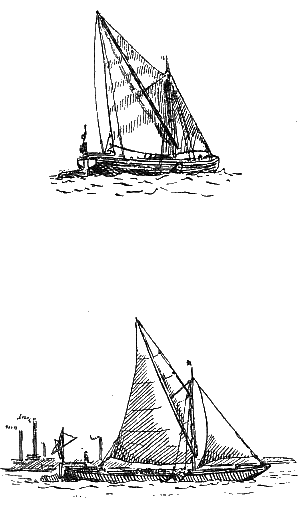 TOP:
STUMPY
TOP:
STUMPY
BOTTOM: OLD FASHION STUMPY
A powerful staysail sheeted to a stout
wooden horse, and a small sprit mizen sheeted to the long
rudder, comprise the sail area of the ordinary stumpy or
pole-masted barge. The larger barges, however, running
from 72 to 80 feet in length, carry a topmast, setting a
big jib-headed topsail, and are known as topsail
barges.
The sails mentioned are invariably
tanned with a preparation of oil and red ochre, to
protect them from the weather, for they are stowed aloft
by brails worked from a hand winch on deck, and are never
covered up. A light flying jib, designated by the
bargeman 'spinnaker,' is set in light weather from the
topmast head to the stem. This is generally of light
duck; and in all the large new seagoing barges a bowsprit
is added carrying a fair size jib as one of the usual
working sails.
In these vessels the mizen, instead of
being stepped on the rudder head as was customary in the
old barges, is stepped well inboard, and is so increased
in size as to be of great use if anything goes wrong with
the mainsail or its spreet. In fact, these craft are
developing for Channel trade into regular ketch barges.
SEA-GOING BARGE
Drawing about 14 feet with their
leeboards down when loaded, and able to float in two feet
of water when light, these vessels are without exception
the handiest cargo carriers in the world. They are fast
to windward, quick in stays, and handy in every point of
sailing in any wind. With a crew consisting only of a man
and a boy, you may meet them with all their rigging
lowered on deck, at Hampton Court, or making their way,
with sweeps out, through the London bridges; with mast on
end, and the vane fluttering 70 feet above your head,
among the fields of Kent, or working under topsail up a
placid creek not wider than your drawing-room; with
close-cropped canvas slashing round Dungeness in half a
gale of wind, or rolling up mid-Channel
merrily.
IN SEA REACH
From Bruges to Plymouth, from the Fal
to the Wash, in any town or village with three feet of
water, there, likely as not, you will find a Thames
barge, with her warm brown sails brailed up aloft, and
her gaudy spreet and stern adding cheerful colour to the
scene.
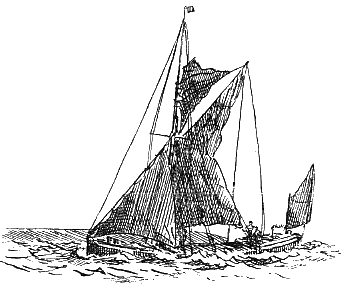
BRAILING UP
As my friend the skipper of the good
barge Mary and Jane said to me one day, as he looked
proudly down at his craft lying with mast and sails on
deck, up at Putney: 'Yes, it's heavy gear that is, but me
and the boy can put it all on end in ten minutes. It's a
bit of a job for two sometimes in a hurry; but see what
she'll do: she'll do anything ye ask in reason, and go
most anywhere's if there's water enough to wet your
boots. She's like a toy, that's what she is,' -- which
explains in a word the ubiquity of the Thames
barge.
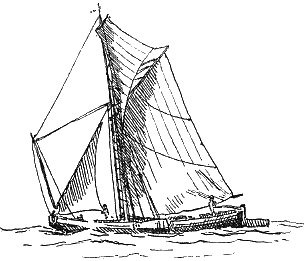
OLD THAMES BARGE, 1820
Deep-sea sailors may look askance at
the barge beating down-Channel in half a gale of wind,
with her decks all awash., but as my friend says in Sea
Reach, pointing scornfully at a high-sided barque rather
tender under upper topsails: 'Lor', I'd rather be in 'er
than in that lot, rollin' like a hempty lighter! I knows
her anyways, and she'll go through more weather than any
man 'as the heart to put her through, she will, and them
sailor men 'll want to be 'ome 'fore me and my barge
takes in our torps'l.'
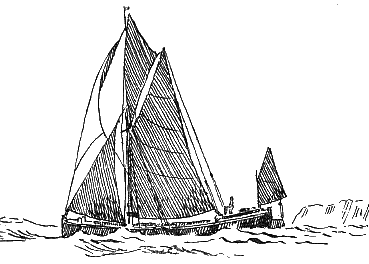
TOPS'L BARGE, OFF DOVER
The form of rig of the Thames barge of
today has not been long stereotyped. In fact, changes and
developments are continually taking place even now. From
old drawings it is evident that the gaff mainsail was at
one time much used in this type of vessel, before it
became so distinctive, and that the squaresail and square
topsail were frequently used in sailing free.
BAY BARGE
The charming and clever drawings of
Mr. E. W. Cooke, R.A., the greatest of our boat artists,
show that as late as 1830 the flat overhanging Dutch bow,
seen still in the dumb lighters in the Thames, was
general. Mr. Pritchett, in his book published in 1899,
also shows this shape of bow in his drawing of a Medway
barge, but at that time it had been practically out of
date for many years. The straight bow of the present day
is quite modern, and undoubtedly makes for speed, and
gives that patient 'take me where you please' expression
which is on the countenance of every decently behaved
barge.
BAY BARGE 1828
In speaking of the Thames barge a word
must be said of her skipper and the boy. So far I have
never met an unpleasant or an incompetent member of
either class; such may exist, but they are few and far
between. They are mostly frank, generous, cheery, and
thoroughly at home in managing the towering masses of
spar and canvas by which they make their voyages in all
weathers by night and day, summer and winter. Like all
true seamen, they are always ready to bear a hand, to
spin a yarn, or to crack up their own ship. They will go
out of their way to oblige you; if you ship for a voyage
they drop the 'sir', and expect you to do your honest
share of work. They will afterwards walk six miles with
you 'to see you off'. They are easily pleased by any
little show of friendliness, and in emergency they are of
all men laconic and swift to act. Once when beating down
Sea Reach on the ebb in a stiff easterly wind, a
condition of things which is often trying to upper spars,
the weather topmast stay of our barge carried away close
to the deck.
LOWERING MAST
I looked aloft and saw the topmast
whip like a trout rod. But by sheer instinct, without a
second thought or a word spoken, my friend the skipper
was spinning his wheel like an express locomotive's
fly-wheel, and round she came upon the other tack. The
boy hearing the report sprang up through the fore-hatch,
and before I could get forward and had dodged a comber
and got round to the lee side, he had secured the broken
end, and in a few minutes all was set up again. She was
put back on the other tack, and then as the skipper
looked approvingly aloft, he took his pipe out of his
mouth, and reflectively made the only remark which passed
on the subject, 'Near thing for the topmast: beautiful
spar,' and then resumed a yarn about his wife.
STUMPY, BRAILED
But a topmast does not always hold on
so long, and when making time into the London river with
an easterly gale, under topsail and brailed mainsail --
an unusual combination of sail-spread which is in great
fashion with the bargeman -- topmast and topsail, with a
crash and a tremendous clap, go soaring away over under
the lee of the mainsail. The boy looks up the after
hatchway and smiles; the skipper remarks, 'There she goes
!' but doesn't move his pipe or a spoke of the wheel.
There is nothing to be done until they get to shelter,
and they know it. But conceive for a moment what
confusion and excitement there would have been on a
Chinese junk, or a French chasse-maree, in the mob which
is usually required to work a vessel of the tonnage of
the Thames barge. *1*
*1* The dimensions are roughly as follows:
- Mast to hounds, 30 ft
- Topmast to hounds, 36 ft
- Masthead, 6 ft
- Length spreet, 53 ft
- 3600 to 4000 sq. ft. sail area.
- 40 to 50 tons register.
- 120 to 125 tons carrying capacity.
- 150 tons displacement.
- 72 to 84 ft. length.
- 14 to 18-1/2 ft. beam.
- 6 ft. loaded draught, 2 ft. unloaded.
- 12 to 17 ft. length of leeboard.
- 8 to 10 ft. drop of leeboard below bottom.
- 7 ft. 6 in. width at bottom.
- Materials: Oak and Oregon Pine.
- Cost: about £1100 for first-class
barge.
The sea-going barges show a tendency to increase in
all principal proportions.
The Bawley
The Bawley is a shallow-draught,
wide-beamed native of the Thames, and is well designed
for the requirements of a fishing vessel which must knock
about the great estuary, dodging along the edges of the
innumerable banks in search of fish, tide-cheating over
dangerous flats, or beating through rough tidal seas in
the open channels. With its high freeboard forward, the
Bawley has a somewhat haughty expression of countenance.
It has a short lower mast, long and clumsy masthead, and
a very long gaff, giving a nearly perpendicular leech of
the mainsail, which has no boom, but is sheeted to a
horse inboard. These peculiarities, with the long, heavy
bowsprit, do not make the Bawley beautiful as regards its
sail plan. Yet no more pleasant-mannered, amenable little
craft exists, and if in a calm the Bawley does look a
rather untidy, badly dressed little creature, remember
her beauty when, with spitfire jib and half-brailed
mainsail, she is soaring over the wicked-looking seas
down Swin in half a gale of wind, light-heartedly shaking
the combers off her that would puzzle many a
twenty-tonner.
BAWLEY
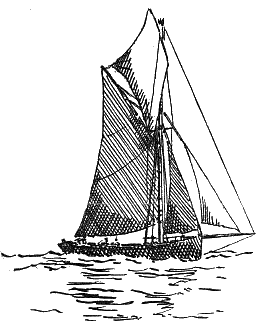 Then
the spirit of the deep can call the beautiful
individuality of a living being out of this ugly,
commonplace-looking little boat. And in the matter of her
dress no type of boat is worse used than the Thames
Bawley; her poor mainsail has no rest in any weather, and
half the time she is under way it is being pulled about
with brails, and having every trick played upon it that a
long-suffering, handy little sail can undergo, brailed up
to check the speed of the trawl along a bank, scandalised
to a passing squall, set up for a turn to windward, or
triced up into the most inconceivable shape for a run
down wind. There used to be many more of these boats in
the Thames hailing from Gravesend than there are at the
present time. The fish have led the Bawley farther
afield, and the more open waters of the present cruising
grounds have resulted in a much larger type of boat than
was known thirty years ago. Leigh, the Medway, and
Whitstable neighbourhoods are now the home of this little
boat, and the casual stranger who visits these places at
low water may be excused for supposing that the Bawley is
a mere kind of mud crab, that spends its time dozing in
placid sleep or meditation.
Then
the spirit of the deep can call the beautiful
individuality of a living being out of this ugly,
commonplace-looking little boat. And in the matter of her
dress no type of boat is worse used than the Thames
Bawley; her poor mainsail has no rest in any weather, and
half the time she is under way it is being pulled about
with brails, and having every trick played upon it that a
long-suffering, handy little sail can undergo, brailed up
to check the speed of the trawl along a bank, scandalised
to a passing squall, set up for a turn to windward, or
triced up into the most inconceivable shape for a run
down wind. There used to be many more of these boats in
the Thames hailing from Gravesend than there are at the
present time. The fish have led the Bawley farther
afield, and the more open waters of the present cruising
grounds have resulted in a much larger type of boat than
was known thirty years ago. Leigh, the Medway, and
Whitstable neighbourhoods are now the home of this little
boat, and the casual stranger who visits these places at
low water may be excused for supposing that the Bawley is
a mere kind of mud crab, that spends its time dozing in
placid sleep or meditation.
BAWLEY, IN SEA REACH
There they lie, reclining at gentle
angles on all sides, their heeling masts looking like the
weathered trees of a small forest bowed in one direction
by the wind. But wait for high water, and see them waking
as the tide comes in to them; sitting up slowly to the
first summons, shaking their mastheads lazily; and then
as they 'fleet' beginning to jump and strain at their
unsentimental anchor-chains, looking this way and that as
they sheer about, longing to be off; and exchanging who
knows what greetings with their neighbours. Not a few
Bawleys may now be seen with a mizen added as a
convenience when working nets, but in some cases it has
resulted in the mainmast being placed a little too far
forward, with a consequent loss of speed: for though the
Bawley is not generally fanciful, she is very particular
as to where you place her mast, and a foot too far
forward may quite spoil her temper when beating to
windward.
BAWLEY-OFF THE NORE
The old Thames boats seldom exceeded
22 feet in length with about 8 feet beam and 3 feet
draught, and were clinker-built, but most of the new
boats are over 30 feet long and about 11 feet beam, and
draw about 4 feet, while they are wholly decked in and
carvel-built.
BAWLEY
Their great beam makes them
delightfully roomy below. A somewhat deeper class of boat
is used on the northern coasts of the Thames estuary, at
Harwich and in the Blackwater, drawing 3 to 4 feet
forward, and nearly 6 feet aft. The crew generally
consists of three men.
CENTRE-BOARD, WITH BALANCE-LUG
A description of the craft of
the Thames estuary would by no means be complete without
some reference to the smart little cutters used in the
oyster and local fisheries, and hailing from Burnham,
Mersea, Brightlingsea, and other small ports situated on
the Essex rivers.
BRIGHTLINGSEA OYSTER-BOAT
They are not unlike the Bawleys,
except that they have somewhat old-fashioned
counter-sterns, and boom mainsails of a pretty yachtlike
cut. The lower mast is longer, and all the gear aloft is
far more taking to the eye than that of the Bawley.
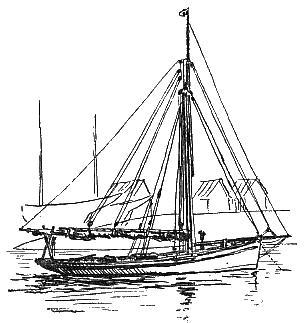 They
are remarkably weatherly little vessels, and form the
recruiting-ground of a large number of our smartest and
best yachting hands, who work their boats in the winter
season and go in yachts during the summer. A hardier
training-ground than these waters in the winter it would
be hard to find.
They
are remarkably weatherly little vessels, and form the
recruiting-ground of a large number of our smartest and
best yachting hands, who work their boats in the winter
season and go in yachts during the summer. A hardier
training-ground than these waters in the winter it would
be hard to find.
The centre-board open boats of
Burnham, rigged with a balance-lug and jib, are very fine
boats of their kind, and would make splendid yachts'
boats for owners cruising foreign in big craft. For they
are powerful, and of strong clench build, and would be
far better adapted for heavy shore work and long sailing
trips than are most yachts' boats, and bright varnished
as they are they would need little doing to
them.
